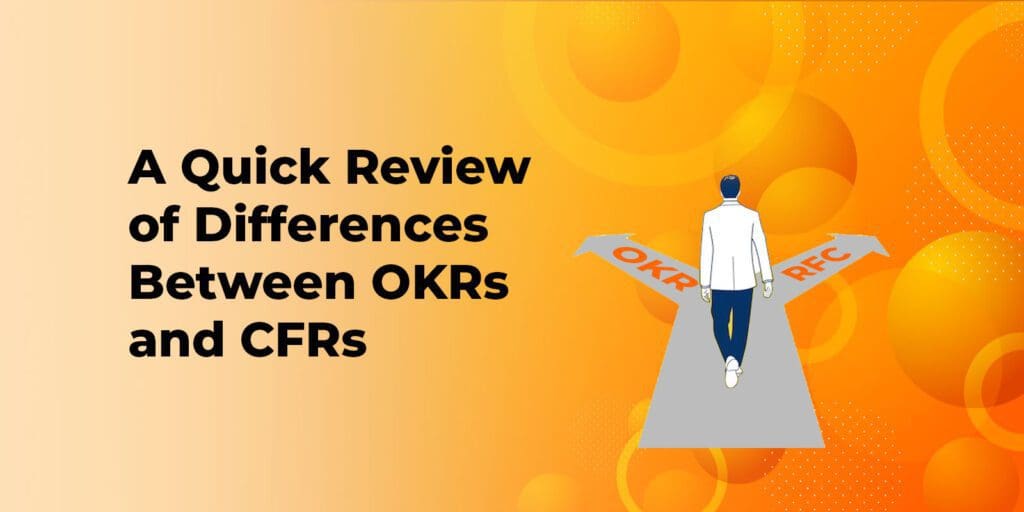Table of Contents
What is Continuous Performance Management?
Continuous Performance Management (CPM) acts as an HR tool for performance management that enables tracking, assessing, and improving employee performance. It prioritises regular and continuous feedback along with employee training and goal-setting between managers and employees. Some of the key features of this method include:
- Maintains regular reviews and feedback
- Guides employees to help them attain their goals
- Sets the benchmark for what to follow
- Improves performance by regularly monitoring and evaluating continuously
- Helps with revising any issues related to poor performance
In the book Measure What Matters, John Doerr CFRs and calls it the ‘sibling’ of OKRs. together, they come became continuous performance management. Let’s take a look at both of these individually and consider their difference to see how to use them best for your company.
What is OKR?
Objectives and Key Results (OKRs) is a goal-setting framework that is action-oriented. It helps with executing the objectives set by an organisation, team members, or individuals. It helps with effective goal setting by setting measurable objectives and regularly tracking the key results. It pushes the employees to sketch and adapt to the larger company vision. This tool was popularised by the father of OKRs, Andy Grove in the early 80s when he coined the term in his insightful book High Output Management.
An effective OKR framework relies on many factors including defined priorities and properly-outlined goals, flexible initiatives, and an environment of continuous feedback. Objectives refer to the specific and measurable ‘what’ goals of an organisation. Key Results refer to the milestones or metrics that show the progress towards those objectives— they are the ‘how’ of an OKR. Finally, an OKR cycle possesses just three steps: align, update, and reflect
What is CFR?
Conversation, Feedback, and Recognition (CFR) is a workplace model that listens to the voice of employees and cares about what they think and feel. The cycle of goal-setting is limited to just numerical targets. CFRs are the human element in an OKR cycle focused on the continuous process of feedback, coaching, and recognition.
An effective CFR model relies on three main factors. John Doerr, a leading figure behind OKRs, describes conversations as, “an authentic, richly textured exchange between a leader and contributor, aimed at driving performance.”
Conversations happen in the form of formal discussions during formal employee reviews. However, conversations in the CFR model are more impersonal and casual, conducted in one-on-one meetings. It helps builds trust and makes the employee feel validated.
Feedback improves employee performance. It promotes the right work ethic. Since it is constructive criticism, employees are encouraged to work on their weaknesses gently and positively contribute to the company. It changes any persistent behavioural habits like delayed deadlines or general work slack.
Recognition is the driving force behind keeping employees motivated to continue working. Peer recognition in the form of a pat on the back or trophies, increments, etc. increases both productivity and general affinity towards the company. Recognition must be transparent to be motivational.


A Quick Glance at the Main Differences between OKRs and CFR
Vocabulary
OKRs have a limited vocabulary of either ‘complete’ or ‘incomplete.’ However, CFRs provide a more inclusive, wider range of vocabulary, especially in defining how progress is.
Time Frame
OKRs are set typically set quarterly and tracked and re-evaluated. As a sibling to OKRs, CFRs happen throughout an OKR cycle. They must not be put off till the end.
Mode of Feedback
OKRs need the help of CFRs to give feedback to employees. In OKRs, feedback happens at the end of a quarter. The ‘conversation’ in CFRs happens in person or via video through 1:1 calls quite regularly.
Maintaining Motivation
OKRs provide a general sense of motivation and alignment with company goals. CFRs take this feeling to the next level and push employees to aim beyond the benchmark to increase their levels of achievement.
Recognition
OKRs are aligned with larger company goals and focus on overall performance. CFRs on the other hand recognise an individual’s performance in a timely manner. OKRs encourage weekly check-ins and together, regular employee recognition is provided.
How to Combine OKRs and CFRs for the Best Outcome?
OKRs and CFRs establish a system of continuous performance management. When used together, 360-degree feedback and continuous employee recognition are provided. Employees attain quick wins that benefit both the company and their team. They align their goals to receive better feedback and recognition, and, in turn, take the OKR framework on its right path.
The daunting objectives and goals set by OKRs may seem like moonshots that are difficult to achieve within a stipulated time. However, since CFRs motivate employees and provide regular feedback, employees even aim for wins rather than simply achieving the OKR targets.
Together, these performance management siblings help reengineer business processes, identify areas of performance improvement, and new market areas, and create a positive environment of learning and development for the employees. They also help improve overall company revenue.
Sign up for free today to start using this amazing OKR tool to take your business to the next level!



